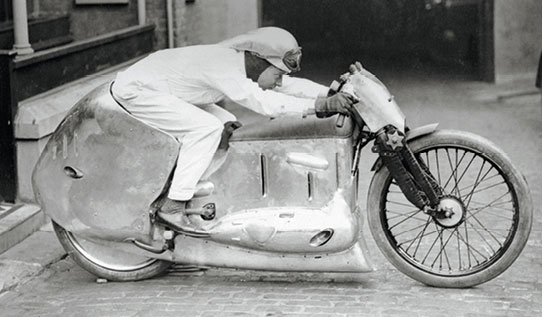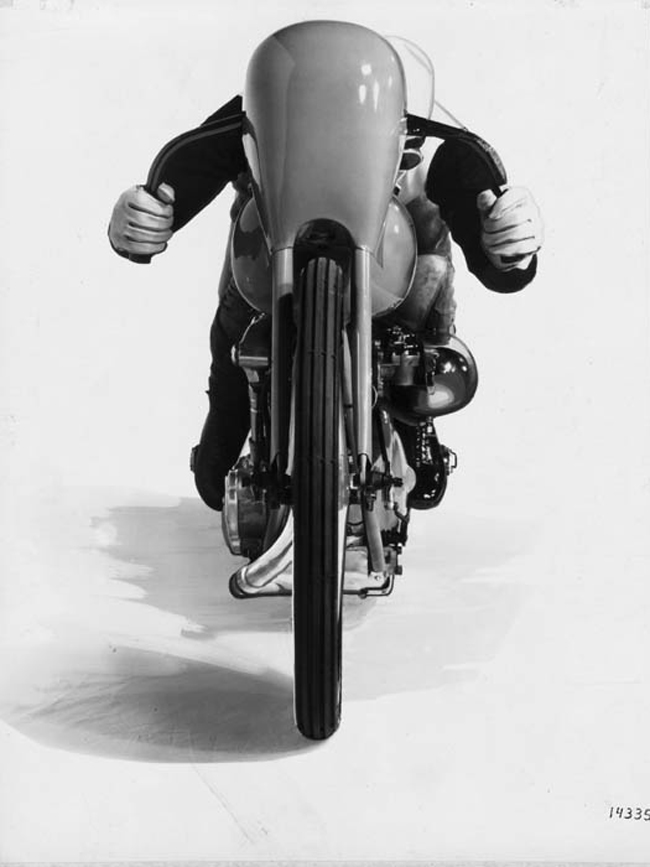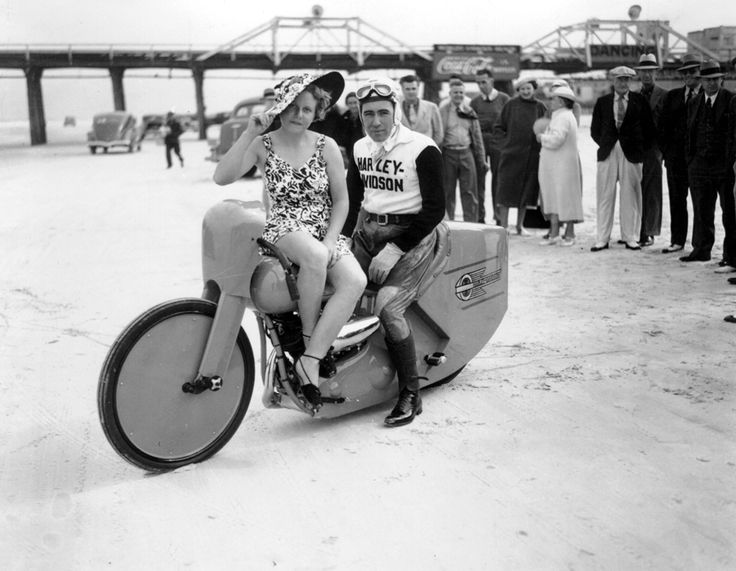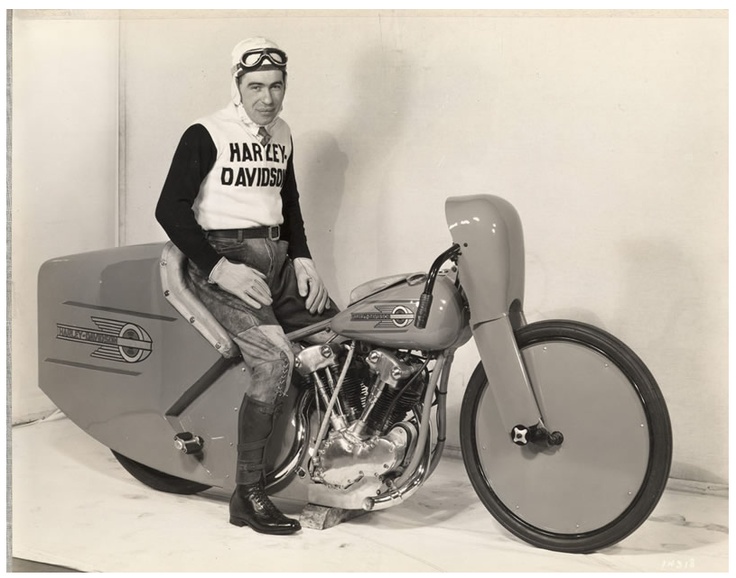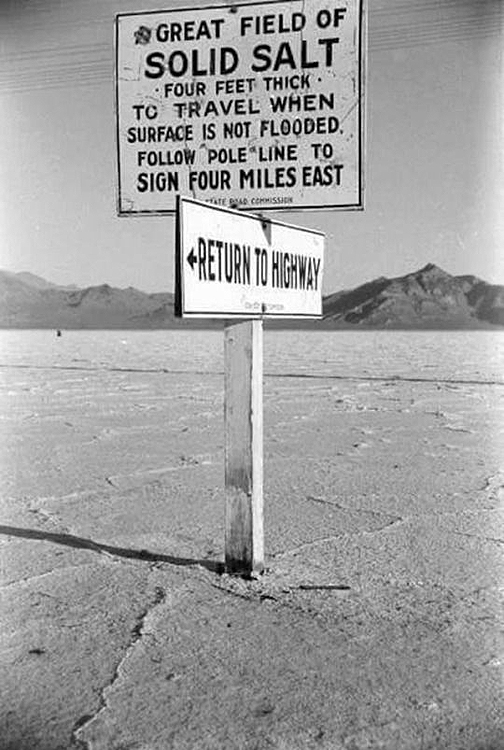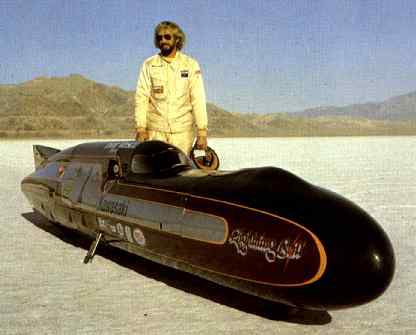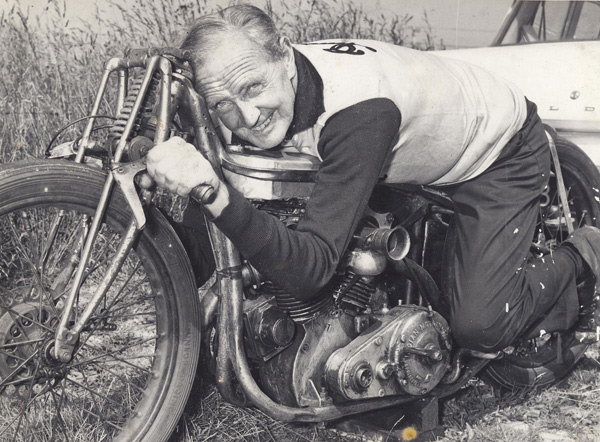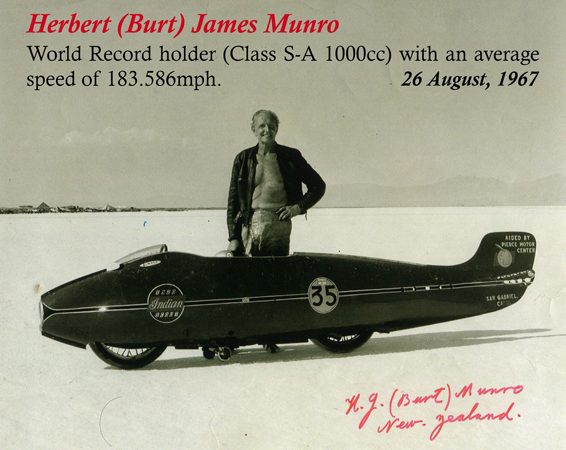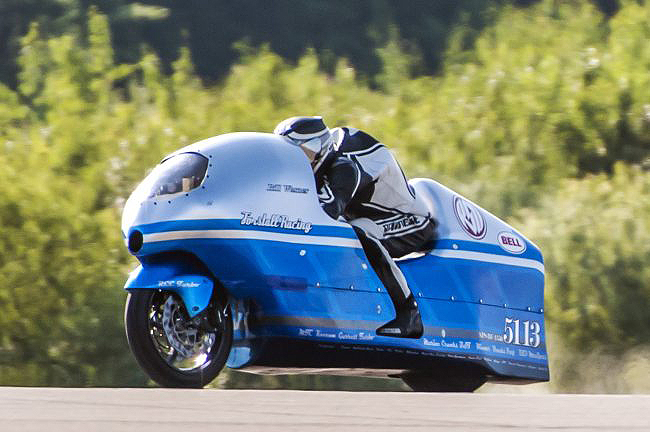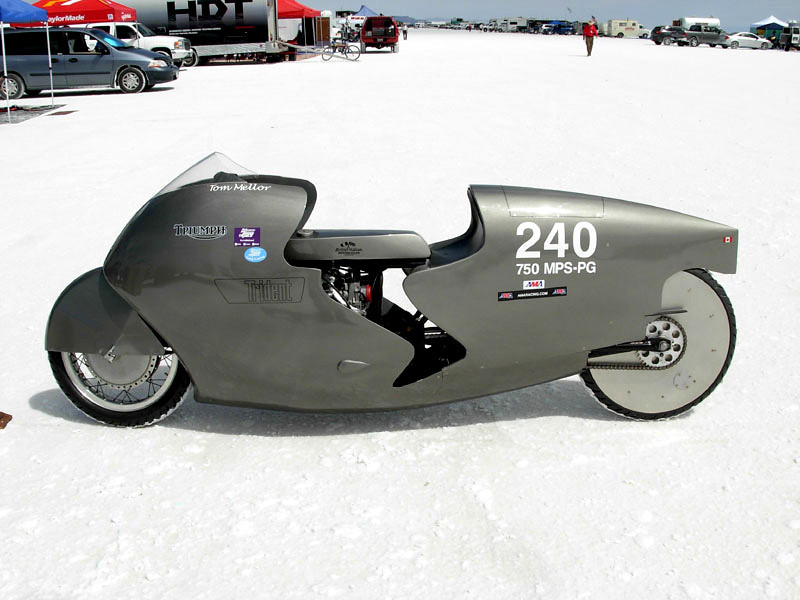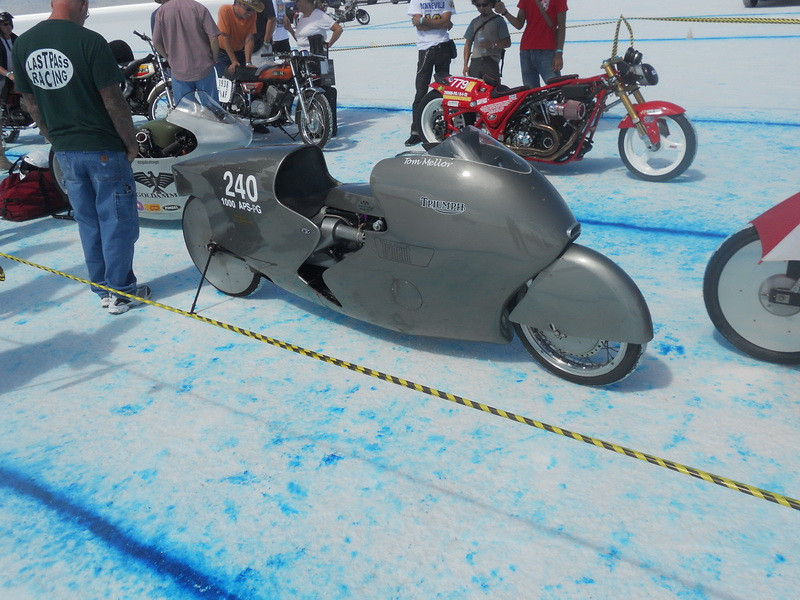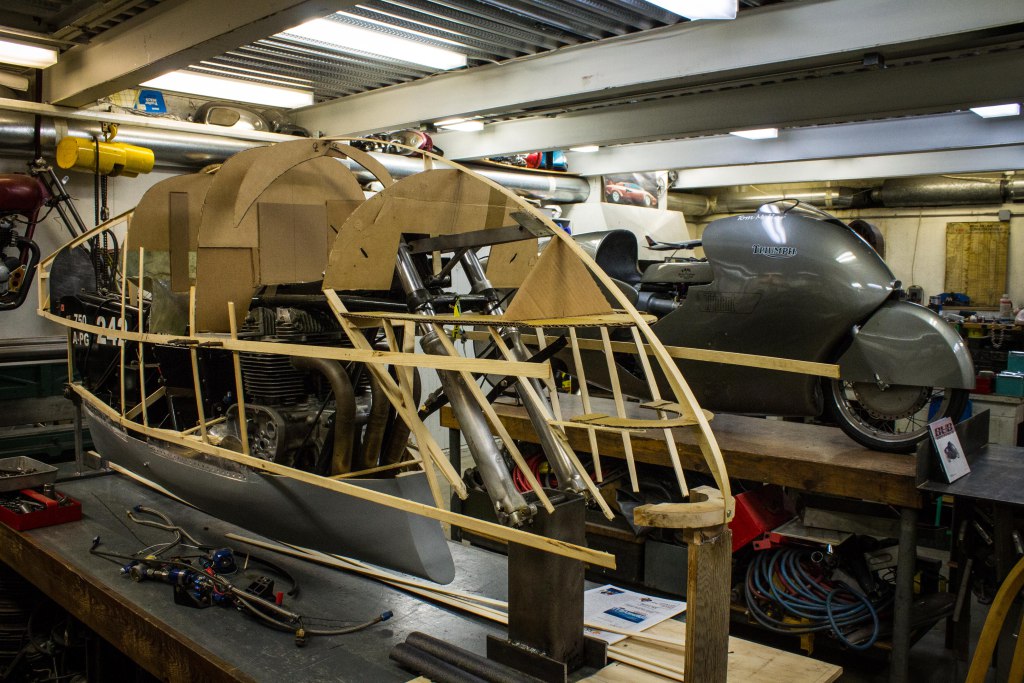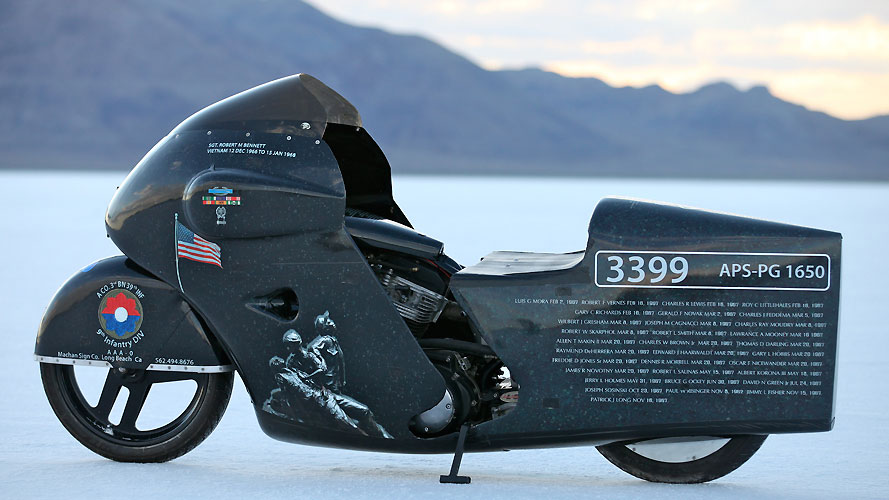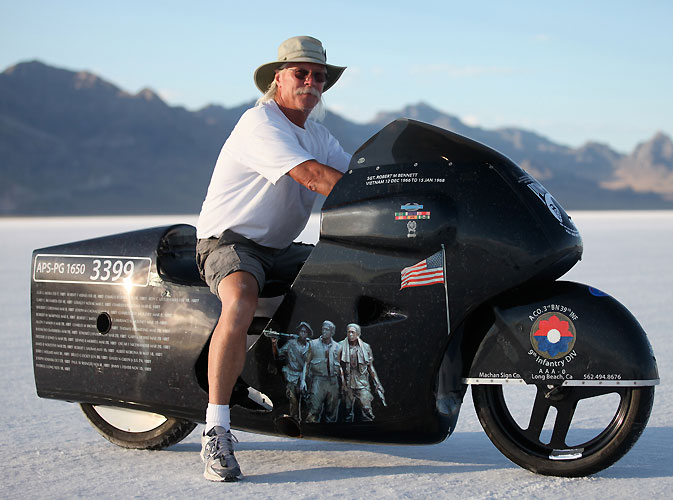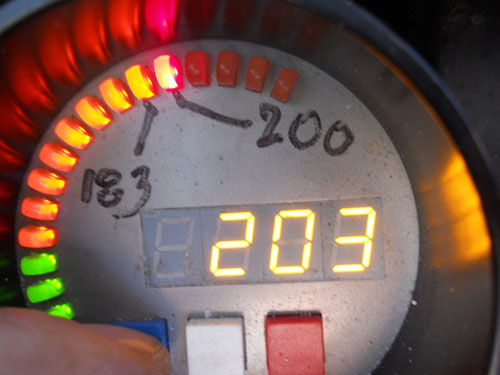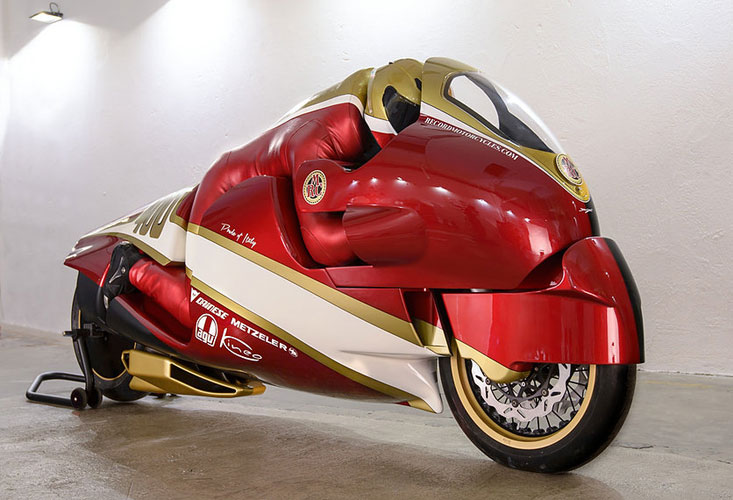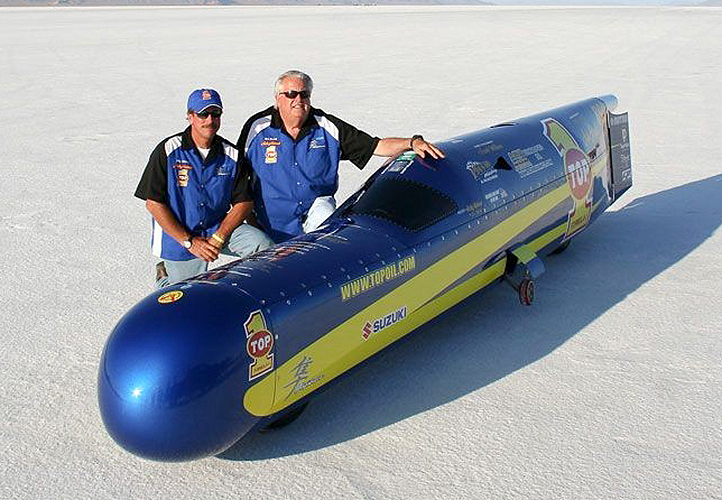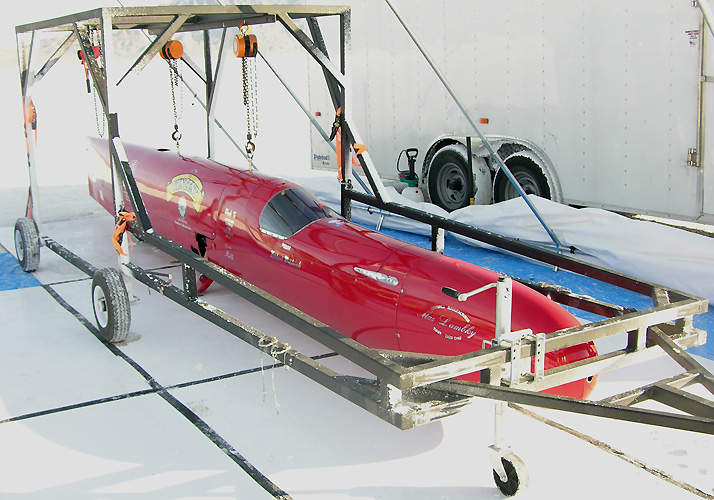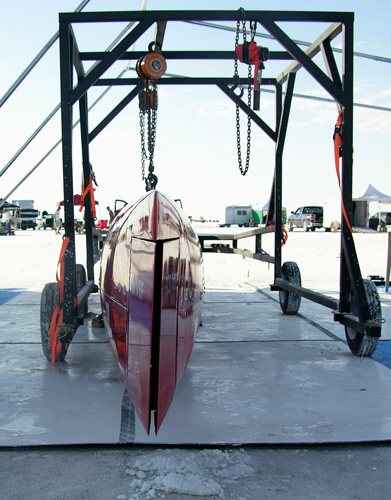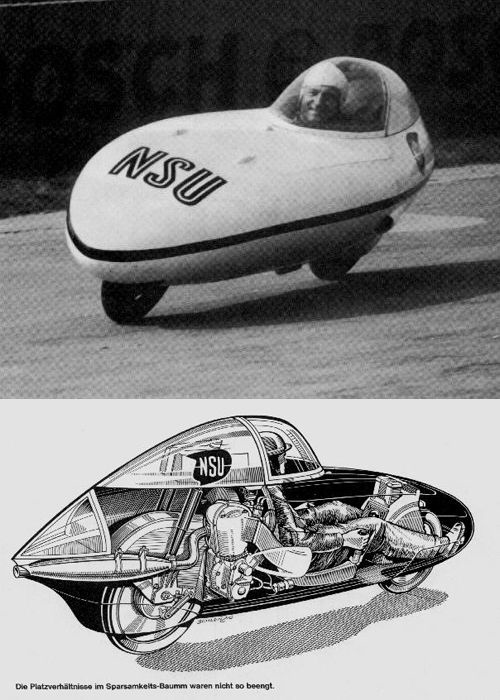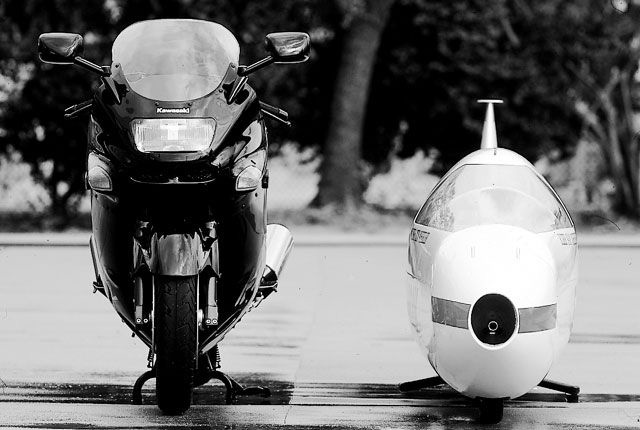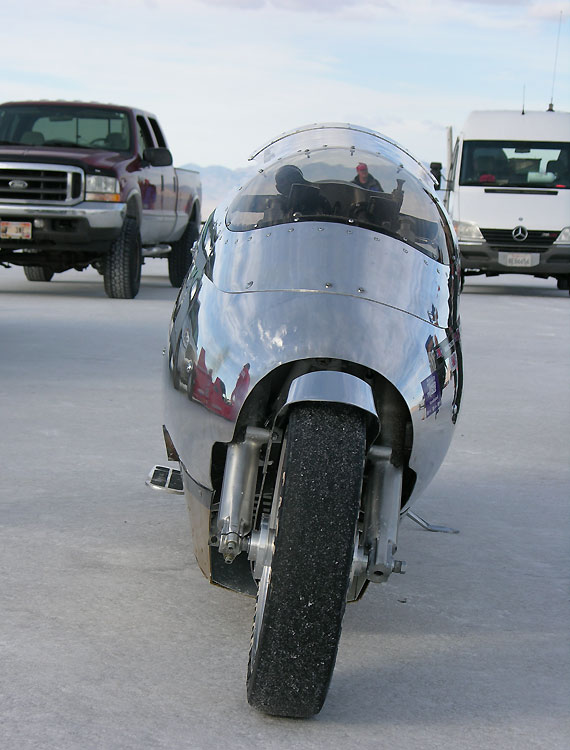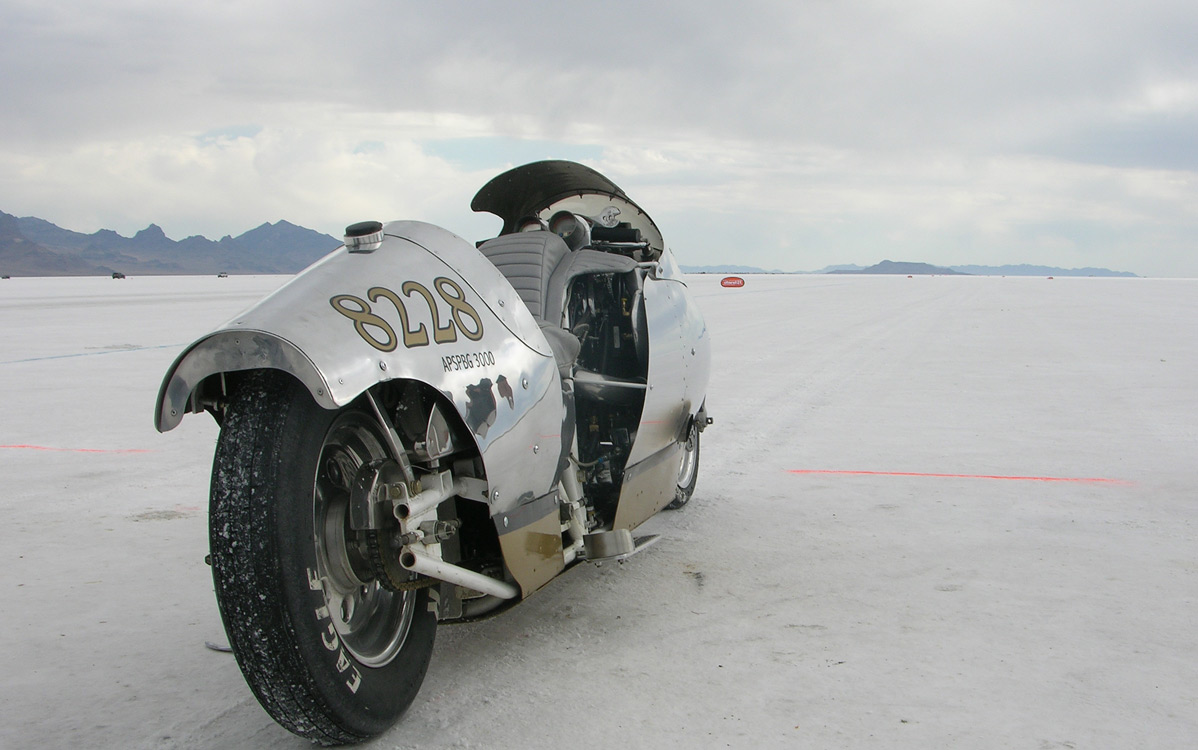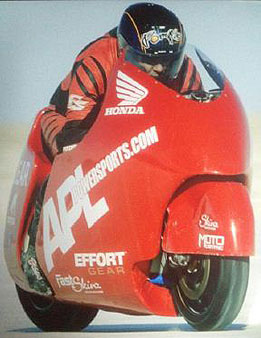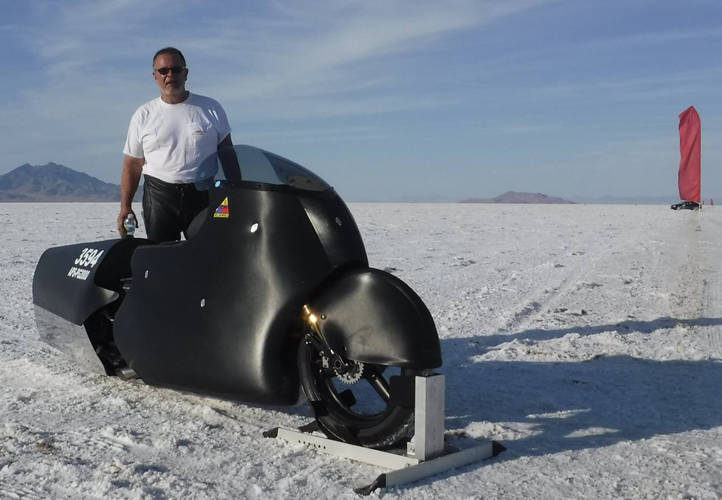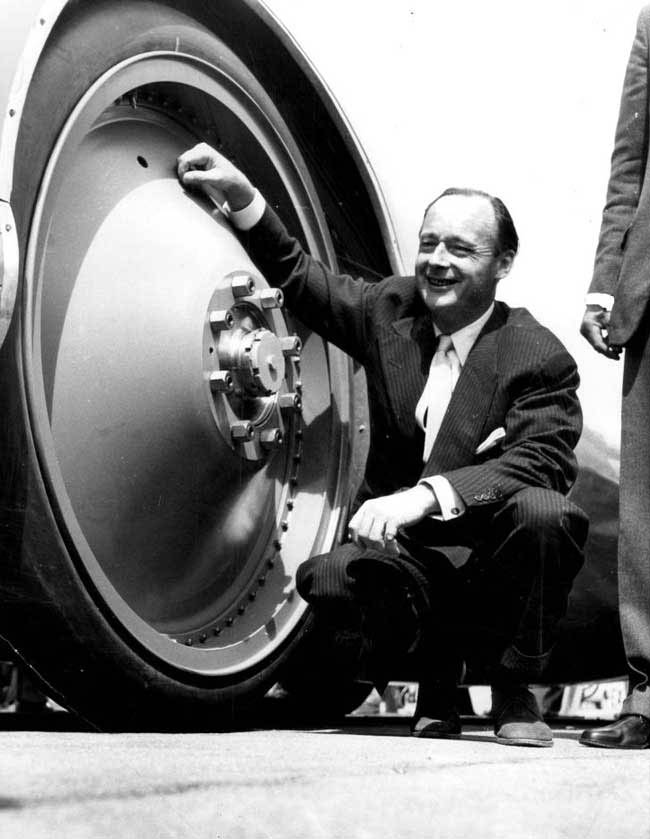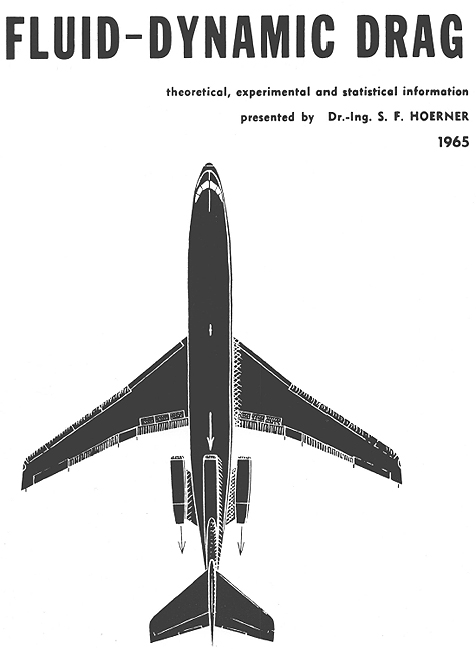|
Aero-Horsepower & Drag Loss Calculator Early Aero
Joe Petrali
Joe Petrali set a speed record of 136.183 mph on the sands of Daytona in 1937. He did not use the tail fairing as it caused handling issues. Nevermore
You can dream all you want
but this is ancient history. The salt is gone,
period...Nothing but a thin crust, only barely
raceable to 4 miles with the crust breaking up . The 12 mile race to the
floating mountain is only in the dreams of the old
competitors who are already dead or are dying off. No more 24 hour records
driving in a circle guided by burning smudge pots. No
more safe spins in a highboy at 270 MPH...you are
going to dig in and roll. They keep moving the course
over trying to keep the meet going...and you may, in
desperation, switch back to the short course hoping
it's better. It isn't. 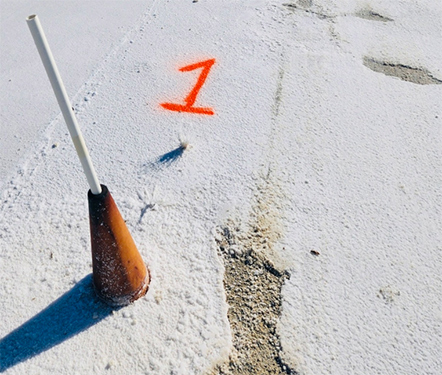 It's more dangerous now...but is still a good photo op. The salt crust is maybe 1/4" thick in some places...All the way from four feet thick many decades ago. It breaks and ruts quickly so the course gets moved over. Motorcycles are told to run down the side to avoid the ruts. It all depends when you were born whether you deem the salt "good" or not...If you were old enough to have raced there 40 years ago then that was your perspective...and it was already going away then with cars stuck in the mud down past the 9 mile marker. 1985 is when we first raced there and there were black streaks off the line...That was our perspective and we went down to the 9 mile. 21st Century: Gun for the "Two" and make sure you have some suspension to deal with the ruts, low spots, and bouncing. August 2022 Save The Salt report. 2025 onward: Efforts to "Save the Salt" are pretty much rendered moot and there isn't any much salt to save anymore. In Case you
Don't Realize this is Now a Drag Race...Speed
Demon 2024 SpeedWeek

1978 – 318.59mph – Don Vesco Kawasaki Lightning Bolt
Burt Munro
About as low as you can go
on a sit up bike / liner. Burt Munro with head at
steering neck height. Met his son but not Burt. Very
narrow, large sail area, long w/ tail for stability.
Not legal by today's rules.
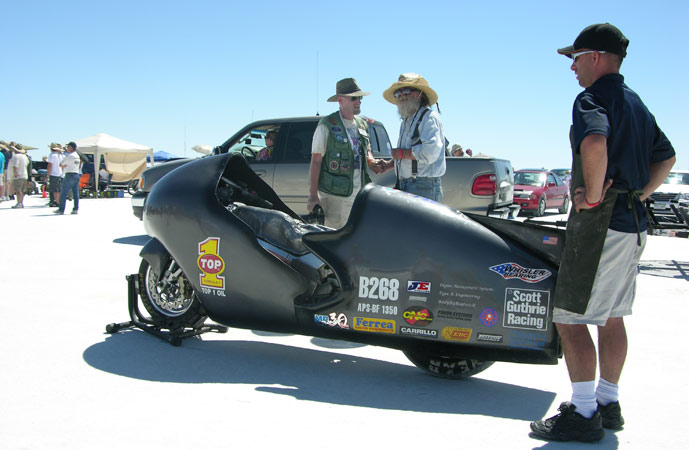 Jon Amo made a one way pass of 272
mph in wet conditions and the rush was on for long
tail teardrop fairings. In subsequent events Jon
struggled with handling issues. No one has gone
faster since 15 years later and probably won't. We
were there in 2009 but driving through salt
water for miles to get to the pits and the start
line seemed a bad idea. Jon found a way. Jon was
the founder of the Landracing website.
Bill
Warner (Deceased)
Gordon Murray, designer or the F1 McLaren and the new T.50, when asked why he did not use carbon wheels...His answer was "They can have sudden catastrophic failure..whereas forged aluminum will not". Guy
Caputo (severely Injured)
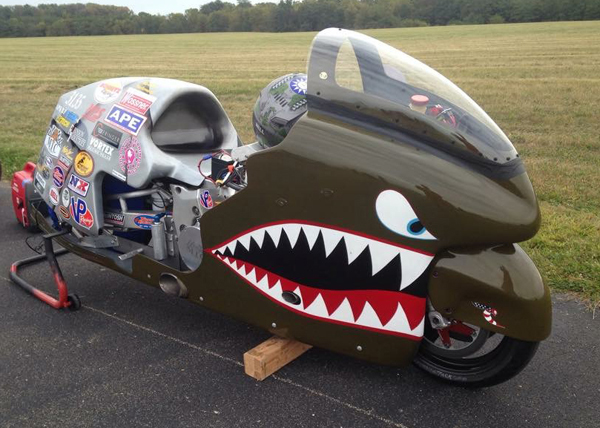 Multiple
record holder with Nitrous, Guy Caputo went down
in a serious crash trying for 300 mph like Bill
Warner. Side winds and a flat bottom with little
lean angle were suspected. Guy survived but with
serious and lingering injuries.
The large majority of these short wheelbase stock frame and rake bikes have crashed, some multiple times. Tom
Mellor
Bike has been raced in both
750cc and 1000cc variations, holding speed records in
both classes. Very efficient aero. New
Fairing Tom Mellor
Pretty much proved
Bonneville has to have purpose built aero...not store
bought aero. Long wheelbase with short overhang.
Bob Bennett Sportster
Early handling issues
were traced to the frame itself. A trip to Dr John's
got that straightened out. Bonneville is a cruel
place...On a record pass his shifter button failed.
Bob has hit 203 MPH (GPS
Speedometer we donated) with 165 HP but is still
chasing his backup run and salt conditions are
terrible and are not going to get any better. Very
efficient.
In 2020 he bumped the record to 197 after missing a few events and a move out of California. Bob Bennett is listed as KIA on the Viet Nam Memorial Wall. As you can see he is still alive although most of his unit were killed...names are on the fairing.
Italians
Concept. Zero
competition.
Easyriders
Harley 322.149 MPH (Fuel record stands)
The double-engined Harley-Davidson streamliner of
Easyriders Magazine's Joe Teresi. Piloted by Dave
Campos it still holds the S-PF (Streamliner Pushrod
Fuel) record at 322.149 mph. The design is by Bob
George and the liner was originally the Jammer liner.
It has an estimated Cd of .2, a frontal area of 5
square feet, and a weight of 2400 lbs. Short overhang
past rear wheel. Rider midships. Regular bars with center hub steering The two nitro burning engines were only putting out
about a total of 380 hp. The engines were tired and
the team was down to their last 5 gallons of nitro but
Dave did the job and the record still stands. If it's
slippery it doesn't take that much horsepower. 300 mph
rated Goodyear rubber, no prominent tail fin, rear
wheel positioned for the long wheelbase and no long
tail overhang. Driver positioned center for best
corrective response. Bub7...Cd 0.09  The last Denis Manning Bub7 liner
has twice as much rear overhang behind the rear
wheel (40% of length) as does Easyrider / Bob George
design (11% of length)...Perhaps making it more
sensitive to side winds. Very low Cd of 0.09 (SAE
study paper).
Non standard orientation grip / push pull controls. Very slippery Cd. Briefly held record at 350 mph with Chris Carr before ACK took it back. Only 500 HP. Crashed at Lake Gairdner at 300+, cause not disclosed. Rider positioned far forward. Denis has more streamliner experience that about anyone dating back 50 years or so and has held multiple records...Nortons, Harleys and his own V4 engine. Dangerous obsession. As of 2024 he's still at it. 100 trips to Bonneville and two to Lake Gairdner and no record. That the definition of obsession if there ever was one.
Ack
Attack Liner: Mike Akatiff and Rocky Robinson
(2024 Record holder)
Currently the world record
holder at 376 mph with two Hayabusa motors. 1000 HP
expected. Rocky actually had a Motec GPS exit data
recording of slightly over 400 mph. The Bonneville
Salt Flats are now too rough, too short, and have too
thin a salt crust for streamliners, so it's off to
Bolivia and 15 miles of rock hard salt. Whether the nose is rounded
or more pointed makes scant difference. It had one
exit speed of 403 mph. 300 mph tires, a rounded bottom, no tail fin (a la Bob George), a long wheelbase with minimal tail overhang and, after a number of record runs, the practical aero instead of an expert's theoretical aero (rear chute doors) was worked out. Full tubular safety structure that has proven itself in crashes. Rocky has more seat time in these than anyone except perhaps the late Don Vesco. Mike is in the aero industry and rider safety is paramount. Survived several crashes
(sound design). Mike Akatiff says it's Bolivia or
nothing...The salt at Bonneville is too thin, broken
up and there is only maybe an iffy 5 miles v. 15 miles
in Bolivia. A return trip to Bolivia
was a bust as issues with the fuel system stopped the
effort. Complex critters. Returned in 2023, as
Bonneville no longer offers a track for these, but
gremlins with the engines, the electric stabilizer
wheels, the rear tail door section, and a suitable
push vehicle led to a last day 303 mph. Huge effort on
a 400 mph quest. Still the record holder with an
unrealized 450 mph potential. 12000 feet altitude and
a long way from home. Note: 2024 Bolivia event
cancelled as fuel could not be delivered in time. LSR
Potential 300 and 400 MPH Tracks. Mike
Akatiff discussion via a Powerpoint
presentation...Later amended after the side winds in
the thin air in Bolivia were found not to be an
issue...hardly noticeable. ACK's 2025 Bolivia event
has been cancelled due to political instability. Lambky Vincent
Only four square feet of frontal area. Keeps breaking
parts. Inspired by Bob George's successful design but
on about a 7/8 scale. Teardrop tapered tail section.
This effort folded with no results and the shell and
the chassis etc, minus the Vincent engines was put up
for sale. Resources, time, money, and age all converge
at some point. Don Vesco once got in it and said he could not see and got out of it. Man machine interface. Was up for sale minus engines after multi-year
effort. Fatal disease. Max Lambky passed away. Streamliner Conundrum
When you up and decide to build a motorcycle streamliner you basically have put yourself into a corner that takes years or decades to get out of...How is that? Well bippie, the conundrum is you can't test the damn thing until you get to the Salt Flats. We've been there with two streamliners and watched it up close building skids, shifter mechanisms, testing fuel systems and doing low speed tow testing at Bonneville and El Mirage...working with Bob George, Dave Campos and Leo Hess. Factor in the weather and
the usual fuckups and you best be in it for the long
haul. Ask Denis Manning, Max Lambky, Vance Breeze, and
Rocky Robinson (fastest). Don Vesco had it down. Take a look at that smile
on the NSU pilot above...try that in your streamliner.
Having fun testing. Sam Wheeler
(deceased)
Sam Wheeler's ZX-11 powered streamliner next to a Kawasaki ZX-11. Bonneville is all about getting through the air. The shape for Sam's Liner was developed at The California Institute of Technology wind tunnel. In the 1997 wind tunnel document you can see Mike Geokan and his #226 Blue Bike in one of the pictures. The Cd is tested at .103. People usually build something then test it. Here it was done correctly i.e. the shape was developed then the shell was made. 2017: Test Run: Sam died in his liner when it went
out or control and he had massive head injuries. Sam
had spent years updating the liner. Perhaps too many
new things at once...Solid metal front "tire" (never
worked for Bob George...he tried it)..New 2 speed
secondary transmission also untested, new Hayabusa
turbo motor, and a new belt final drive; Bolted
together rear frame structure, not a full welded
tubular one. 20 years later you put on weight and it gets more
crowded in the cockpit...helmet too close to roll
hoop. Hard to exit in fire suit. You can put these streamliners on a dyno but you just can't drive them around so testing is done minutes at a time years or decades apart..Sam had more decades of experience than anyone except the late Don Vesco. It is a dangerous undertaking. Not sure there was any post crash analysis...There
seems to be a pass on this unless there are four
wheels involved. Was not a full tubular structure post
the rider. It swerved at maybe 140 mph, penciled, and
broke apart. Severe head trauma. Bonneville Bullett
The Bonneville Bullett with a 139" ORCA Turbo motor.
Here pictured at the 2009 SCTA-BNI World Finals where
it qualified for long course at 191 mph in 3rd gear.
1000 lbs and about 425 hp if the boost is turned up.
It ran 191 with about 9 psi in 3rd gear getting the
new rider his seat time and licenses. Cd is estimated
at .476 and a frontal area of 5.5 feet. Rider and bike
weigh 1250 lbs. 300 mph LSR tires. We ended up buying
about $4,000.00 worth of these tires. Bryan Stock got a 200 mph record at low boost.
Now the salt is mostly gone. Like with the
streamliners, it's not a bike you can easily test i.e.
ride until you get there. Personnel involved rejected
dyno testing to 200 mph on our extended wheelbase
Superflow CycleDyn. Notice the floorboards with the rider's feet exposed
to the air where they can get blown off. We made some
left and right heel restraints for the bike but the
owner declined saying they were not necessary...As in
" All you have to do is have piece of carpet on the
salt and wipe your feet off at the start line". Beyond
stupid.
We finally put the right one on, drilled, bolted and red Loctited, not asking anyone before so doing. We did not get the left one on as we would have had to cut off the heel shifter which would have been a political statement. Well, maybe Bryan can hang on at 200+ with one leg anchored. Politics of insanity. It was only briefly run up to 345hp @ 19PSI. Bike geared for 312 mph @ 6500 RPM. Turbo was sized for 560HP but with low RPM (6500 rev
cut 6750) and small valve area relative to
displacement 425 HP @ 6500 if taken out to 30psi. We left this project when the owner got a bit ornery
and definitely unappreciative. Has not gone faster
after we got Bryan a 200mph record in 2011.,,long long
ago. Ralph
Hudson (Deceased) ...262 MPH Mojave Mile..and 297
MPH Record in Bolivia...Crash SpeedWeek 2020 @
252mph
Currently fastest sit up
bike in the world...shooting for 300 mph back to back
runs in Bolivia. Ralph designed the fairing.
Dunlop Road Race tires not certified for 300 mph.
Change tires each run if they chunk...700lbs. Ralph
tried LSR car tires but could not get his bike to
handle. Ralph tried tire warmers but the tires chunked
easier. They were never shaved. One way 307 MPH. Ralph
designed his own bodywork...Rounded bottom closed
tail. Ice-cooled water to air intercooler. Minimal
rear overhang. Over 500HP with 1000cc! 141mph in 1st gear. Well
sorted Motec electronics by Shane Tecklenburg. Years
and years of development. New chilled air to water
intercooler and bigger Xona Rotor Turbo for the 12000
feet altitude in Bolivia. Bolivia is the best bet for 300+. COVID-19 cancelled the 2020 year trip. Bigger turbo (Xona Rotor) for 12000 ft altitude in Bolivia. He was still faster than a Bugatti Veyron. SpeedWeek 2020: After setting a record with his 600cc bike Ralph crashed on a return record run with his 1000cc bike, going down at 252 mph. Possible cause...sidewind. Ralph passed away...he was 69 years old. Last interview of Ralph before his final run. Not sure of current regs
relative to side winds. Long ago...Back in 1985 it
seemed that 5 MPH was the cut off point. The winds can
vary down the course, so having a readout of the side
winds at the two, four, and six mile points is
critical. Not sure that is a go anymore as we have
seen 14 MPH side winds at the start line and people
were still going. Maybe no one to stop Ralph on his
return run that last day when gusts were reported up
to 9 mph and can be worse down the course where a gap
in the mountains funnels the side winds. Al Lamb
Charlie Toy based fairing from Airtech (Now Closed). Road race tires not certified for 300 mph. Two trips to Bolivia...the second trip the bike arrived too late due to shipping issues. Damn. The bike was subsequently modified
with a longer tail to improve the Cd. which will make
it more susceptible to side winds. You best have your
own three spotters down wind with aneometers to give
you a go or no go with the trigger being 5mph.
Gusts from a gap in the hills from the left will push
the tail around and veer you left. For 2023 bike was
completely redone but engine and turbo gremlins
resulted in one last day pass at 260. Cruel place. 2024 was a disaster. 2025
was cancelled. Maybe 2026. Tom Bookhamer
120 CID Harley
motor...transmission breakage got Tom at
Bonneville but he's back with a Baker 6 speed
Grudge Box that hopefully won't break. Tom
worked to lower the Cd a bit after a trip to a
wind tunnel where he made improvements in
laminar flow by preparing removable fairing
sections. In his first
trip he managed to get inspected and licensed
for long course before his transmission broke.
He's a senior engineer and had it all worked out
then the salt bears got him. So it goes.
At his next
SpeedWeek, where he did not run due to salt
conditions, on the way home he and a big rig
were cut off by a woman driver making a sudden
lane change for an exit ...his race trailer
rolled. The driver that cut Tom and the big rig
off went on her merry way and did not stop. His
aluminum fairing was destroyed so Tom started
over with fiberglass shooting for 2024, as 2023
was a wash-out. It's a long
expensive trip from Florida. Tom is rebuilding
and upping the horsepower....plus a new trailer. You are at the
mercy of the elements so to call it a crap shoot
is correct. Get lucky once and then years
afterwards zero success...has happened to lots
of people. Best get the money photo shots. In 1992 we put Henry
Louie and Fred Wiley into the 200 mph club
(Red Hat) on their first try on our Turbo
GSXRs...They thought it was easy. It
isn't....It's all preparation, 5000 miles of
testing, and luck.
Rubber
Tires: Donald
Campbell's Dunlop tires only had .050" of rubber
and were tested in a special bunker constructed
by Dunlop to 450 mph. 52" tall they were
inflated to 130 psi. No thick rubber to build up
heat and chunk. With the advent of the turbo Jap
bikes that we pioneered in 1989 with the GSXR
Suzuki's going 200 was easy...We limited them to
255Hp which was enough to push them to 215+
pretty much instantly on asphalt...and 203 on
the salt with 34 mph wheelspin. Aero wall. Later on the more
aero Hayabusas made 250+ attainable with up to
500Hp...and the motorcycle tech station was full
of chunked tires. Tire failures put people down
like Jason McVicar at 242MPH. Streamlined
teardrop motorcycle bodywork followed. Jon
Amo made a one way pass at 272 mph at the
World of Speed in 2009. Side winds became the enemy of teardrop bodywork along with a deteriorating course with ruts and thin crust. It got dangerous
fast. Nate
Jones and Son...Nate Jones Cowboy Tire
Nate
Jones and his son with the Bullett's
2017 Goodyear LSR tires...Mounted,
shaved and balanced. Nate wants everyone
to know that shaving new tires whether
it's for Bonneville, your new pickup
truck or your $200,000.00 Porsche Turbo
Carrera will make the vehicle safer and
smoother as even new molded tires are
not perfectly round and, if not shaved,
require more balance weights than needed
to try to correct the out of roundness.
All Bonneville motorcycle tires whether
Z-Rated or Road Race slicks should have
additional shaving to remove excess
rubber to cut down on heat build-up on
the long course at Bonneville to prevent
chunking. Even the Bullett's
$650.00 tires get shaved and balanced.
Nate Jones Cowboy Tire 1-562-597-3369. When
we first went to Bonneville in 1985 the
late Jack Dolan, of two and four wheeled
Bonneville fame, advised us to get
Goodyear Road Race Slicks and have Nate
Jones shave and balance them. It's
something we have done ever since. Zero
problems with the Bullett's LSR rubber
prepped by Nates. People have died using
tires not rated for these 200+ mph
speeds and it's damn stupid to have the
excess rubber that a street tire has.
Z-Rated does not cut it on the great
white dyno. Tire shaving has been around
a long
time. Why LSR turbo bikes do not get heir tires shaved at Nates is a mystery. Guess the old guard like Jack Dolan took that advice with them. __________________________ Circa 2006 Jack Dolan Quote re LSR: "LSR stuff is different and is forever. If you make a rule change, it should be the minimum to follow technology and safety and never obsolete anything that has gone before . Burt (Munro) is an example of how it should be done. His package should never be allowed to run today because the safety requirements that have proven themselves time and again would not allow it. He did know about the value of shaved and prepared tires and that is a lesson that is still tough for some to swallow. Now that does not include shoe polish in the cracks but you should know how to care for the tires." Fluid-Dynamic Drag
|
|
RSR Bonneville Aero-Horsepower
& Drag Loss Calculator:
Calculate your horsepower requirements based on the physical limits of drag and frontal area. To get correct gearing for your top speed runs use our Gearspeed Calculator . Simply enter the four figures for your vehicle and see what you face horsepower-wise to meet your objectives. Keep in mind that you can never have enough horsepower. However, all the horsepower in the world won't help you if you are limited by a high Cd or traction on surfaces like Bonneville. Coefficient of Drag: Street, faired motorcycles are notoriously inefficient aero-devices with Coefficient of Drag (Cd) figures in the .6 range. For example a Suzuki Hayabusa has a Cd of .561 whereas a Kawasaki ZX-12 has a Cd of .603. Modern cars often have paid close attention to aerodynamics and may have Cd figures of .3 . Streamliners may have Cd figures of under .2, perhaps as low as .15 or in some cases figures of .10 have been achieved. Frontal Area: Reducing frontal area is key to going fast as the horsepower requirements go up exponentially as you push that "barn door" through the air. You'll need a close approximation of your vehicle's frontal area in square feet to make this calculator entry. A Suzuki Hayabusa has a frontal area of 6.01 square feet. A Kawasaki ZX-12 has a frontal area of 6.09 square feet. Some streamliners like the Lambky Vincent have only 4 square feet frontal area. Vehicle Weight: On shorter courses with asphalt surfaces and good traction weight is more of an issue than it is at Bonneville where weight can aid traction on the slippery salt surface. Short courses are more of a drag race and accelerating extra mass is not a good idea. At Bonneville the big dogs will be on the long course with over six miles of salt with the clocks at the 2 , 4, and 6 mile markers, so weight is not nearly as much of an issue. Speed: Miles per hour that is
your objective. Remember when you set your gearing for
Bonneville that you have to plan for wheelspin due to
the slippery conditions. This can be factored into our
Gearspeed Calculator. The
biggest mistake you can make at Bonneville is to gear
too close to your intended speed... Traction Control: Bonneville
salt is not white asphalt. It is wet, has high and low
spots, ruts from vehicles, and the surface varies as
you go down the course. Traction control is complex
and we view it more as a safety issue as too much
wheel spin can bring the rear end around. On asphalt
15% slip will provide the greatest acceleration but
this is excessive for Bonneville. Too low a slip
figure like 3% can cost you a record if it cuts in.
10% can be too much wheel spin. Complex issue. Fuel
cut, ignition retard, FBW throttle programming, and
boost programming...lots of variables. Fuel cut is
safe. |
|
|
